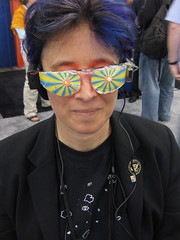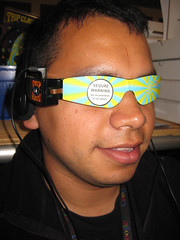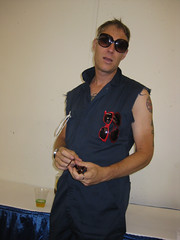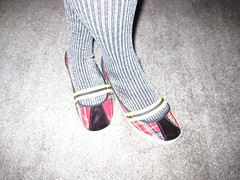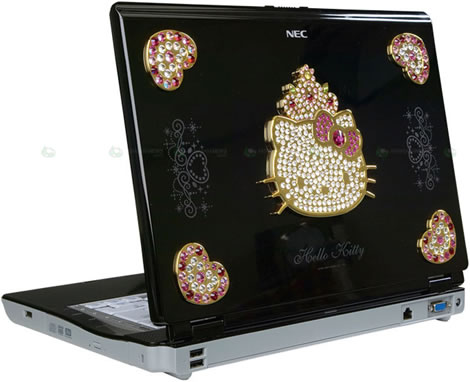I got an HP Mini Vivienne Tam edition to review a few days ago, and I’ve used it so far for blogging, surfing, email, IM-ing, and writing up my thoughts in Notepad. Here’s my preliminary review based on four days of casual but heavy use.
This is a good computer for a blogger or a student who doesn’t need a huge screen or massive computing power. Also it’s incredibly cute.

Here’s some praise!
I’m a demanding blogger. I type 100 words a minute and I like to have about 50 tabs open. This HP Mini was incredibly easy for me to slip into using. I blogged from it without noticing the slightly smaller keyboard; I could type just as fast as I usually do. The size, key placement, action, and feel of the keys are all just great. If you’ve tried a mini before, but had trouble getting used to the keyboard, you may be pleased with a Mini.
The screen is big and very readable! It’s tiny and very light.
I like the way the case opens and shuts. The shell is hard plastic – not fabric or gelskin covered.
It has two USB ports, which seems quite nice.
I’m happy with a 60GB hard drive in such a tiny, light computer.
The wireless mouse works well.
Everything I wanted out of my Asus EeePC, but sadly never quite got, has come true in this adorable netbook!
Here’s my wishlist.
I fervently wish for holes in the case where I could attach straps. Two holes near the hinge would be ideal, so that I could put a shoulder strap on this beastie. At She’s Geeky conference this weekend, how many women did I just watch, walking around the room holding a computer, a paper notepad, a pen, a purse, and a latte? Around the house, it would be all that plus a book and a baby and 6 things you’ve picked up from the living room to move to the office. Computers need handles. But beyond the OLPC or old clamshell iMac handles that require a hand. Shoulder strap power!
Backlit keys would make me *very* happy. I’m often typing in bed or in a darkened room, in work meetings or conferences. It’s lovely if I can see the keys, but keep the screen relatively dim.
Neutral thoughts
* Mostly, I use MacOS X or Linux. So this is the first time I’ve used Windows. While I’m not especially impressed with Windows XP, I’m also not especially annoyed. So for a week or two, I’m going to stick with XP to give it a fair shake.
* I haven’t tried doing any development on this machine yet, but I think that will go quite well.
* I haven’t tested battery life. So far, it hasn’t been a problem, but I haven’t approached it systematically.
* I haven’t tried the webcam yet. It has a built in camera! I will take it through some video chat paces.
* I haven’t tried installing any games or a Second Life client on it. I’ll let you all know how that goes. I figure, I don’t play a ton of games, but if Second Life behaves well, then I can stand by my recommendation the computer for the writer and student who’s also a casual gamer.
My criticisms of the HP Mini are minor.
* The computer goes to sleep a bit too quickly when I half-close the lid. I’m often blogging or emailing or IM-ing in social or work situations, or doing actual work with private information in a cafe, and if someone comes up to talk with me, I need to half-close the computer so they can’t shoulder-surf. While the Mini wakes up very quickly, I wish it didn’t go to sleep until I *actually shut the lid*.
* The bumps on the f and j keys are too subtle for me to feel them easily. I could type with more confidence with better subliminal feedback about the “home” keys.
* The hinge on the case could open a little more widely. It goes past 90 degrees, but not quite far enough. I type in my lap, not on a desk. This is partly habit I’m sure, but I wonder if it’s at all a gender related habit, as chairs, desks, and tables often don’t match up for me, because I’m shorter than the default person (male) they’re designed for? Because the computer’s in my lap, and the resulting viewing angle, I sometimes need to tilt the screen further back than 100 degrees. Now, this is also true when I have my HP Mini in bed. Which I often do.
AND NOW FOR THE ADORABLENESS
This computer is cute. It’s pretty. But it doesn’t make me hurl with the pinkitude. Really!
It’s a really nice color of deep red, with black around the screen. There’s nothing ugly and clunky about this computer. It’s totally elegant. I take it out of my bag, and everyone admires it, and whatever one might think about HP’s targeting of women or the cut of the marketing, women everywhere I go are exclaiming with delight at how cute this computer is. It is very much OMG I WANT THAT. Then, because I’m this sort of person, I hand them the computer and invite them to type something and take it through its internet browser paces. In fact, it’s been really fun to have people come up and talk to me and be so friendly, because they’re curious about my computer.
For quite some time I’ve been asking the world for an adorable computer that is small and light, yet still a useful computer. (Oh, how I miss my 12 inch MacBook, but how I wished it were *even smaller*.) While I have issues as a feminist with everything being pink especially like, pink tools and pink computers, (see girl geek bingo), I also have mixed feelings and like things that are pretty and cute. It’s better if they’re pretty, cute, and punk rock, and actually work.
This is my usual style (me and my sister, with 13-inch MacBooks covered in stickers)
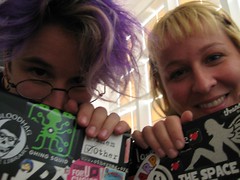
And here I am with the Vivienne Tam,

This gets across how tiny and handy it is. See how it likes to sit on top of my MacBook?! It’s like a cute little ladybug!

The Internet is srs bzns and so am I, in black boys’ guayabera, SF State tshirt, cotton handkerchief with red stitching, and matching computer,

The Vivienne Tam and its matching mouse want to wear my Fluevog boots:

If it had a hat, it would have a beret. If it were a color of nail polish, it would be “I’m Not Really a Waitress” red. Yes. I have middle class brand awareness. I cannot help it. When I wasn’t playing video games, I grew up in a mall. It seeps into your blood.
Even the packaging was nice! It was like buying a computer at Sephora. Or Bloomingdale’s or something. I know it’s shallow, and obviously I care WAY more about the specs and usability of a computer than the box it
comes in, but I noticed the box anyway. Check this out:


At the She’s Geeky / Women 2.0 Dinner, I ended up passing the computer around almost as much as I got to use it myself. And when I whipped it out of my backpack to show to my friend Beth aka Techmama, she yelped and pulled out her own! We were like, “Oh no, same dress at the prom!” We managed to share the cuteness!
I can heartily recommend this computer if you’re a blogger, writer, or you just want your own laptop instead of using a shared family computer. The 60 GB hard drive is big and fast enough to deal with the *ton* of photos, Flip videos, and music that I tend to accumulate as a blogger. The wireless also works very well so the machine lives up to its promise of portability.
ALSO, IT IS REALLY CUTE. Did I mention that!?
I have three matching wireless mice to give away. Red mice with lavender flowers and silver sides. Who wants them?
* Buy it from HP: HP Mini Vivienne Tam (“Buy it” link gives all the specs)
* Buy it from Amazon:HP Mini 1140NR 10.2-Inch Netbook – Vivienne Tam Edition (1.6 GHz Intel Atom N270 Processor, 1 GB RAM, 60 GB Hard Drive, XP Home, 3 Cell Battery)

